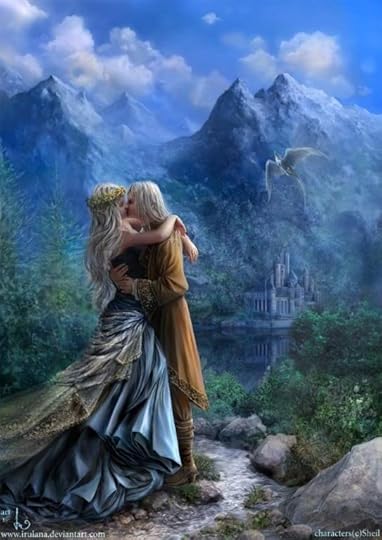Lisa Kumar's Blog, page 9
March 12, 2011
The Writing Tree
 While driving, I often think of writing-related matters. For some reason last week, I thought of how climbing a tree -- or even the tree itself -- is like writing a book. In the winter trees are bare, branches sticking out like spindly arms without any leaves to clothe them. But I reasoned, are these limbs like the structure we hang our stories on?
While driving, I often think of writing-related matters. For some reason last week, I thought of how climbing a tree -- or even the tree itself -- is like writing a book. In the winter trees are bare, branches sticking out like spindly arms without any leaves to clothe them. But I reasoned, are these limbs like the structure we hang our stories on?But how is writing a novel like climbing a tree -- or the tree itself? Well, a tree grows, as we all know. From a sapling, it starts out fresh and green. As the tree matures, it becomes stronger. Once the tree has developed enough stability to withstand our weight, we can begin the upward climb. Many people don't make it past the first few limbs, or even the first one, and give up in defeat. For those who persevere, the first few branches might not seem to be that high from the ground. We can climb these sturdy limbs with minimal effort.
But once we go higher, our comfort level drops, and the branches become more delicate. We have to constantly watch for missteps, testing each limb to see if it will hold the weight of our story ideas. One branch may look perfect, but once we're on it, we can see it's not the place for us. The limb may be too shaky, or not close enough to other branches to allow easy movement. So we search out another branch that will take us toward our goal--of climbing the tree to the top and back down. Along the way, we have to jump from limb to limb as our plot-points change, sometimes going up a branch, sometimes down two.
Depending on the person and story involved, climbing can be very easy or extremely hard. And just like a cat that gets stuck in the top branches, we can shoot to the top on an idea, only to realize there's no way to get back down.
Plot twists, conflict, characters -- they can all lead us astray, leaving us stranded in the tree we've built for our story. Sometimes, we can gingerly retrace our steps down. Other times, we need to be recused -- whether by a critique partner or by time and objectivity. But with enough patience, we will make it to the top and back down -- in one piece.
Writing is all about the journey. From the inciting incident at the bottom to the conflict at the top, and then back down again. Apparently writing is like a tree -- and climbing that said tree -- to me. What is writing to you?
Image: domdeen / FreeDigitalPhotos.net
Published on March 12, 2011 11:06
March 5, 2011
Signed with Astraea Press
This week I signed on with Astraea Press as a new author. This is a very exciting time for me. So far I've filled out an author form and a cover art worksheet. They have beautiful cover art done by the talented Elaina Lee. Take a look: http://astraeapress.com/
Now I've begun pre-edits, reading for certain words that weaken the story. Wow, I thought I had ripped out alot of them already, but quite a few slipped past me! I'm being as diligent as I can to remove the rest, so hopefully Stephanie, my editor, won't be able to point out too many instances.
Well, that's my quick update!
Now I've begun pre-edits, reading for certain words that weaken the story. Wow, I thought I had ripped out alot of them already, but quite a few slipped past me! I'm being as diligent as I can to remove the rest, so hopefully Stephanie, my editor, won't be able to point out too many instances.
Well, that's my quick update!
Published on March 05, 2011 11:12
March 4, 2011
What's in a Character? Part Two
Welcome the second part of my character recipe. Last time we discussed how dialogue, actions, and thoughts contribute to a well-rounded and fully-developed character. This last part consists of character emotions, which is something I believe is overlooked too often in the hustle and bustle of writing.
Emotions
Emotions are often reflected through dialogue, thoughts, and actions. Think of it as an underlying base, one that's often missing. Writers can nail dialogue, action, and even thoughts, but forget to weave in emotion. Without it, a scene falls flat because we have no emotional connection with the characters. In romance that's a death blow. I think most understand how to use emotion through dialogue. When combining it with thoughts and action, however, it requires a delicate balance.
For instance, take the example:
She was so mad at her cheating boyfriend that she wanted to kick in him in the groin. If he tried to see her, that's what she would do. Now that she had a plan, she smiled as she sat in the dark.
Pretty flat, right?
Though not perfect, here is an example where I tied emotion to the spurned woman's thoughts and actions:
Samantha sat in the darkening living room, hunched over on the sofa. Though she could barely see anything, she didn't bother to turn on the lamp. What did light matter to her, anyhow? Darkness suited her better -- all because of him. Her hands clenched as her heart threatened to explode. The image of her boyfriend wrapped in the arms of another woman infiltrated her mind.
A bitter laugh escaped her lips. How could she have believed that Jackson and Kayla were merely friends? The answer was easy. She'd seen what she'd wanted to see. Straightening her shoulders, she devised her next move. If he dared show his face here, she'd whoop his butt. A kick to the groin should do it. A devious grin spread over her lips. Oh yes, if he was stupid enough to come around, he'd regret it.
How do you develop characters and make them unique? Well, that's the end of my two part series. Hope you enjoyed!
Emotions
Emotions are often reflected through dialogue, thoughts, and actions. Think of it as an underlying base, one that's often missing. Writers can nail dialogue, action, and even thoughts, but forget to weave in emotion. Without it, a scene falls flat because we have no emotional connection with the characters. In romance that's a death blow. I think most understand how to use emotion through dialogue. When combining it with thoughts and action, however, it requires a delicate balance.
For instance, take the example:
She was so mad at her cheating boyfriend that she wanted to kick in him in the groin. If he tried to see her, that's what she would do. Now that she had a plan, she smiled as she sat in the dark.
Pretty flat, right?
Though not perfect, here is an example where I tied emotion to the spurned woman's thoughts and actions:
Samantha sat in the darkening living room, hunched over on the sofa. Though she could barely see anything, she didn't bother to turn on the lamp. What did light matter to her, anyhow? Darkness suited her better -- all because of him. Her hands clenched as her heart threatened to explode. The image of her boyfriend wrapped in the arms of another woman infiltrated her mind.
A bitter laugh escaped her lips. How could she have believed that Jackson and Kayla were merely friends? The answer was easy. She'd seen what she'd wanted to see. Straightening her shoulders, she devised her next move. If he dared show his face here, she'd whoop his butt. A kick to the groin should do it. A devious grin spread over her lips. Oh yes, if he was stupid enough to come around, he'd regret it.
How do you develop characters and make them unique? Well, that's the end of my two part series. Hope you enjoyed!
Published on March 04, 2011 12:07
March 2, 2011
What's in a Character? Part One
Developing a well-rounded character can be a challenge. Though I'm no expert, this is what I've noticed is needed for a recipe of good characterization: dialogue, actions, thoughts, and emotions.
While I'm separating these four factors into their own category, each is intertied and can't, or at least, shouldn't exist without the others. Originally I was going to post this article as one entry, but it became too long and unwieldy. So I'm separating it into two parts:
Part 1 -- dialogue, actions, thoughts
Part 2 -- emotions
Now on to the first part!
Dialogue
Dialogue helps define your characters' personality. How they talk clues us in to a lot of details -- a general location of where they may have grown up, how educated they may be, what they're feeling, and so on.
Each character should have a distinct talking pattern. As we all know, a person growing up in Ireland sounds different than a person who was raised in the States. Even within one country, though, there are so many different dialects associated with geography and socio-economics.
Actions
I'm not talking about fight scenes. Any movement or action that places our character in the world outside her mind is enough to fulfill the criteria. We need action in our stories to ground the character in her surroundings.
Otherwise, every scene might as well just take place in a giant white room. Setting the mood and tone with the character's surroundings is a beneficial tool in characterization. I go more into this below in the Thoughts section, so read on!
Thoughts
Thoughts are a front seat to the character, as they illuminate emotions and what the character plans to do next. The downfall with thoughts, though, is when a writer stays too long in a character's mind without letting the reader see the fictional outside world.
To avoid this, we need to add in some kind of movement or action. Have the character notice and interact with his surroundings in a way that reflects his mood. If he's happy, he might notice and admire the bright sky while walking outside. If angry, the same bright sky may annoy the heck out of him. Or you may choose to echo his mood with black clouds roiling overhead. Also, if the character isn't alone, have him strike up dialogue.
Do you have any 'favorite tricks of the trade when it comes to weaving in dialogue, actions, or thoughts to character development? If so, share them here!
Please join us for the next part, which I will have up sometime later this week.
While I'm separating these four factors into their own category, each is intertied and can't, or at least, shouldn't exist without the others. Originally I was going to post this article as one entry, but it became too long and unwieldy. So I'm separating it into two parts:
Part 1 -- dialogue, actions, thoughts
Part 2 -- emotions
Now on to the first part!
Dialogue
Dialogue helps define your characters' personality. How they talk clues us in to a lot of details -- a general location of where they may have grown up, how educated they may be, what they're feeling, and so on.
Each character should have a distinct talking pattern. As we all know, a person growing up in Ireland sounds different than a person who was raised in the States. Even within one country, though, there are so many different dialects associated with geography and socio-economics.
Actions
I'm not talking about fight scenes. Any movement or action that places our character in the world outside her mind is enough to fulfill the criteria. We need action in our stories to ground the character in her surroundings.
Otherwise, every scene might as well just take place in a giant white room. Setting the mood and tone with the character's surroundings is a beneficial tool in characterization. I go more into this below in the Thoughts section, so read on!
Thoughts
Thoughts are a front seat to the character, as they illuminate emotions and what the character plans to do next. The downfall with thoughts, though, is when a writer stays too long in a character's mind without letting the reader see the fictional outside world.
To avoid this, we need to add in some kind of movement or action. Have the character notice and interact with his surroundings in a way that reflects his mood. If he's happy, he might notice and admire the bright sky while walking outside. If angry, the same bright sky may annoy the heck out of him. Or you may choose to echo his mood with black clouds roiling overhead. Also, if the character isn't alone, have him strike up dialogue.
Do you have any 'favorite tricks of the trade when it comes to weaving in dialogue, actions, or thoughts to character development? If so, share them here!
Please join us for the next part, which I will have up sometime later this week.
Published on March 02, 2011 07:08
What's in a Character?
What's in a character?
Developing a well-rounded character can be a challenge. Though I'm no expert, this is what I've noticed is needed for a recipe of good characterization: dialogue, actions, thoughts, and emotions.
While I'm separating these four factors into their own category, each is intertied and can't, or at least, shouldn't exist without the others. Originally I was going to post this article as one entry, but it became too long and unwieldy. So I'm separating it into two parts:
Part 1 -- dialogue, actions, thoughts
Part 2 -- emotions
Now on to the first part!
Dialogue
Dialogue helps define your characters' personality. How they talk clues us in to a lot of details -- a general location of where they may have grown up, how educated they may be, what they're feeling, and so on.
Each character should have a distinct talking pattern. As we all know, a person growing up in Ireland sounds different than a person who was raised in the States. Even within one country, though, there are so many different dialects associated with geography and socio-economics.
Actions
I'm not talking about fight scenes. Any movement or action that places our character in the world outside her mind is enough to fulfill the criteria. We need action in our stories to ground the character in her surroundings.
Otherwise, every scene might as well just take place in a giant white room. Setting the mood and tone with the character's surroundings is a beneficial tool in characterization. I go more into this below in the Thoughts section, so read on!
Thoughts
Thoughts are a front seat to the character, as they illuminate emotions and what the character plans to do next. The downfall with thoughts, though, is when a writer stays too long in a character's mind without letting the reader see the fictional outside world.
To avoid this, we need to add in some kind of movement or action. Have the character notice and interact with his surroundings in a way that reflects his mood. If he's happy, he might notice and admire the bright sky while walking outside. If angry, the same bright sky may annoy the heck out of him. Or you may choose to echo his mood with black clouds roiling overhead. Also, if the character isn't alone, have him strike up dialogue.
Do you have any 'favorite tricks of the trade when it comes to weaving in dialogue, actions, or thoughts to character development? If so, share them here!
Please join us for the next part, which I will have up sometime later this week.
Developing a well-rounded character can be a challenge. Though I'm no expert, this is what I've noticed is needed for a recipe of good characterization: dialogue, actions, thoughts, and emotions.
While I'm separating these four factors into their own category, each is intertied and can't, or at least, shouldn't exist without the others. Originally I was going to post this article as one entry, but it became too long and unwieldy. So I'm separating it into two parts:
Part 1 -- dialogue, actions, thoughts
Part 2 -- emotions
Now on to the first part!
Dialogue
Dialogue helps define your characters' personality. How they talk clues us in to a lot of details -- a general location of where they may have grown up, how educated they may be, what they're feeling, and so on.
Each character should have a distinct talking pattern. As we all know, a person growing up in Ireland sounds different than a person who was raised in the States. Even within one country, though, there are so many different dialects associated with geography and socio-economics.
Actions
I'm not talking about fight scenes. Any movement or action that places our character in the world outside her mind is enough to fulfill the criteria. We need action in our stories to ground the character in her surroundings.
Otherwise, every scene might as well just take place in a giant white room. Setting the mood and tone with the character's surroundings is a beneficial tool in characterization. I go more into this below in the Thoughts section, so read on!
Thoughts
Thoughts are a front seat to the character, as they illuminate emotions and what the character plans to do next. The downfall with thoughts, though, is when a writer stays too long in a character's mind without letting the reader see the fictional outside world.
To avoid this, we need to add in some kind of movement or action. Have the character notice and interact with his surroundings in a way that reflects his mood. If he's happy, he might notice and admire the bright sky while walking outside. If angry, the same bright sky may annoy the heck out of him. Or you may choose to echo his mood with black clouds roiling overhead. Also, if the character isn't alone, have him strike up dialogue.
Do you have any 'favorite tricks of the trade when it comes to weaving in dialogue, actions, or thoughts to character development? If so, share them here!
Please join us for the next part, which I will have up sometime later this week.
Published on March 02, 2011 07:08
February 27, 2011
Captive Review from Leilani Loves Books
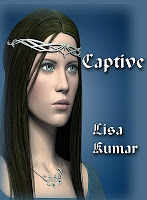 This will be a very brief post, as I just have to share my good news! A fantastic new review for Captive is up on Leilani Loves Books. Click on over (the link is embedded in the 'Leilani Loves Books' in the previous sentence) to read it and share in on my moment!
This will be a very brief post, as I just have to share my good news! A fantastic new review for Captive is up on Leilani Loves Books. Click on over (the link is embedded in the 'Leilani Loves Books' in the previous sentence) to read it and share in on my moment!Thanks!
Lisa
Published on February 27, 2011 15:44
February 26, 2011
The Branding Scramble
 A few days ago I was interviewed at the Romance Books R Us blog. I found this quite exciting, yet cringe-worthy. "Cringe-worthy?" you might ask. Yes! Exciting because I need to get my name out there. Cringe-worthy for the same exact reason--I'm getting my name out there.
A few days ago I was interviewed at the Romance Books R Us blog. I found this quite exciting, yet cringe-worthy. "Cringe-worthy?" you might ask. Yes! Exciting because I need to get my name out there. Cringe-worthy for the same exact reason--I'm getting my name out there.Reviews affect me the same way, even fantastic ones. These are precious manna, more precious than gold, and just as hard to come by when starting out. I also have to take the bad with the good, and this phenomenon is something every author will contend with sooner or later. Make peace with it and move on.
I don't think it will come as a surprise I'm an introvert by nature. Privacy is a way of life for me. Whether I'm putting a request, or excerpt of my work out there, I'm also putting something of myself out there right along with it. Writing can be a lonely business, but promoting is the exact opposite to me. Just like any other product on the market, my work is a 'good' that I want people to buy. Now, more than ever, authors have to do their own promo, essentially selling (branding) themselves, not just their work.

It's never too early to start building a name for yourself as a writer. Many of these opportunities will not just fall into your lap, and you'll have to actively seek them out. This endeavor takes time, and for me, practice. Time away from writing and revising. Learn to accept these facts and start now, so i
 t won't be so overwhelming later.
t won't be so overwhelming later.Take author interviews --opportunities like these are great because other readers and writers learn a little bit about you and your works. Even if you're not a published writer, you can still be interviewed as an aspiring writer at many sites.
A good idea is to compile a list of review and interview sites to have available. Once you're published, you don't want to be scrambling to find that info. Also keep in mind many of these sites are back-logged, so request early and expect a 'No' or two.
Make connections and build networks. Online friends are much more likely to help you when your promo comes knocking on their door than a stranger would be. The same goes for groups. Don't just be a drive-by shooter with your marketing. Get to know the people in the group whenever possible. Of course, this means you're going to have to pick the groups best suited to you. Otherwise, you'll spend twenty-four hours a day running around the internet. If you have time, start a blog or join one to guest blog.
The twenty-four hour scamble on the net--I already feel that way sometimes. But I trust in the end it will all be worth the while. What are your takes on promoting yourself? Is it something that excites you? Does it cause dread to fester in the pit of your stomach? Or is it a love-hate relationship?
Published on February 26, 2011 10:46
February 24, 2011
Romantic Roots
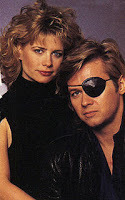
When I was a girl, my sister and I spent summers as latch-key kids. We woke each weekday morning at 10:30 or 11:00 a.m. (How we slept that late I'll never know.) The first thing we did was turn on the TV with a press of a button on the actual television set and tune in to The Young and the Restless at 11:00, followed by All My Children at 12:00, Days of Our Lives at 12:30, One Life to Live 1:00, Another World 1:30 and General Hospital at 2:00. At 3:01 p.m. we would scramble like hell to clean the house and do our chores before Mom and Dad came in from work at 5:00.
All day long we engrossed ourselves in soap operas. Some of which overlapped. Without the benefit of Tivo or even a video recorder in the early days, it could be a true dilemma with far reaching consequences to decide which show to watch. What if Hope had gotten shot the day before on Days but Jessie was professing his love to Angie on AMC. How could you choose?
These were the glory days of daytime television with an abundance of heroes to go around.

Does anyone remember Rick Springfield as Dr. Noah Drake, or Michael Damian as Danny Romalotti? What about Jack Wagner, John Stamos, Peter Reckell, Peter Bergman…etc.?
These guys were my first introduction to romance, and they were excellent teachers. In fact, now when I need a great hero name or a mental picture of a character, I check the ranks of daytime television. Not always the best actors but certainly some of the prettiest. I still smile when I think of Steve "Patch" Johnson calling Kayla "Sweetness" or a leather-clad Bo Brady with Hope in a wedding dress on the back of his motorcycle after saving her from marriage to the evil Larry.
Sadly, the daytime serials of years past are fading away as reality has set into the minds of the American population. Fantasy and romance are no longer in vogue. Snooky and The Situation take focus
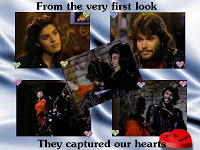 over The Quartermain and Horton Clans. My beloved soap operas are a dying art form. Many have been cancelled and more are in jeopardy.
over The Quartermain and Horton Clans. My beloved soap operas are a dying art form. Many have been cancelled and more are in jeopardy.In truth, I haven't watched soaps for decades, but I do revisit those tantalizing nineteen eighties hay-day plotlines for inspiration. I fondly reminisce over favorite couples and kisses, and revel in the unbelievable twisting plotlines that stretch the suspension of logic passed imagination. I mean how many long lost kids, mothers, sisters, lovers, brothers can one person have? Stefano DiMera has died and been resurrected so many times he makes Jason and Michael Myers look like lightweights.
But the true staple of these stories was the romance -- the heart-pounding, knuckle-biting, will-he-kiss-her suspense that is the essence of our addiction. The soap opera more than any other medium has the ability to capture epic romance that literally spans decades.
This addictive romantic core is what enthralls and drives us romance lovers to read, watch, and write new stories.
Today in my first blog post ever -- I want to pay homage to the
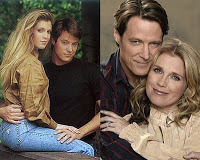 romance genre that, for me, started it all.
romance genre that, for me, started it all.Thank you, daytime TV, for the hours of guilty entertainment and education in the art of romance. May my own work strike as definitive a chord with others as yours has with me.
Published on February 24, 2011 14:43
February 22, 2011
Welcome to Lisa and Kary's Escape into Fantasy blog!
This is our first post. We plan to blog about all things writing -- fantasy and romance included. That's the genre we're both writing in now, so it holds a special place in our hearts.
Tag along on our journey as writers, whether you're a reader, writer, or none of the above. We'd be glad for the extra company. After all, the greatest adventures are those that are shared. And romance writing is all about the journey and, yes, the fantasy.
No matter the subgenre in romance, the author takes you into his/her own world, with larger-than-life characters guiding the story. This world becomes your world while you're in between the pages, or in the case of an e-reader, the page turns.
Join us and escape into fantasy!

Tag along on our journey as writers, whether you're a reader, writer, or none of the above. We'd be glad for the extra company. After all, the greatest adventures are those that are shared. And romance writing is all about the journey and, yes, the fantasy.
No matter the subgenre in romance, the author takes you into his/her own world, with larger-than-life characters guiding the story. This world becomes your world while you're in between the pages, or in the case of an e-reader, the page turns.
Join us and escape into fantasy!
Published on February 22, 2011 19:09

